
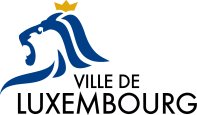
LUXEMBOURG VILLE - COEUR DE PAYS
LËTZEBUERG STAD
Samedi 21 Août 2004
|
Lakme |
|
pour agrandir
les photos, cliquez dessus |


LUXEMBOURG VILLE - COEUR DE PAYS
LËTZEBUERG
STAD
![]() also called Letzeburg, capital of Luxembourg, in the
south-central part of the country. Luxembourg city is situated on a sandstone
plateau into which the Alzette River andits tributary, the Petrusse, have cut
deep, winding ravines. Within a loop of the Alzette, a rocky promontory called
the Bock (Bouc) forms a natural defensive position where the Romans and later
the Franks built a fort, around which the medieval town developed. The purchase
of this castle in AD 963 by Siegfried, Count of Ardennes, marked the beginning
of Luxembourg as an independent entity. The castle's old name, Lucilinburhuc (“Little
Fortress”), is the origin of the name Luxembourg.
also called Letzeburg, capital of Luxembourg, in the
south-central part of the country. Luxembourg city is situated on a sandstone
plateau into which the Alzette River andits tributary, the Petrusse, have cut
deep, winding ravines. Within a loop of the Alzette, a rocky promontory called
the Bock (Bouc) forms a natural defensive position where the Romans and later
the Franks built a fort, around which the medieval town developed. The purchase
of this castle in AD 963 by Siegfried, Count of Ardennes, marked the beginning
of Luxembourg as an independent entity. The castle's old name, Lucilinburhuc (“Little
Fortress”), is the origin of the name Luxembourg.
The old town consists of Luxembourg Castle's surviving fortifications, the Grand
Ducal Palace, Notre Dame Cathedral, and other historic buildings. The city
eventually spread westward, and the suburbs of Grund, Clausen, and Pfaffenthal
developed in lower-lying sections across the Alzette from the old town. These
sections are linked by several bridges.
Over a 400-year period, Luxembourg Castle
(Château de Luxembourg) was repeatedly attacked and rebuilt by the Spaniards,
Austrians, French, and Dutch, successively, to become the strongest fortress in
Europe after Gibraltar. One such reinforcement was undertaken by the French
military engineer Sébastien LePrestre de Vauban, who redesigned the city's
defensive fortifications after having orchestrated its siege in 1684 in the
service of Louis XIV.
From after the Congress of Vienna (1815) to 1866, the fortress was garrisoned by
the Prussians as a bulwark of the German Confederation. With the Treaty of
London, in 1867, Luxembourg was declared neutral, and the fortress, containing
15 miles (24 km) of casements, three battlements with 24 forts, and an extensive
(10-acre [4-hectare]) area of military barracks, was largely dismantled, an
operation that took 16 years. Today visitors can tour the remaining 7 miles (11
km) of casements or view the modern city below from the Chemin de la Corniche, a
promontory built atop the old town wall.
The Grand Ducal Palace (Palais Grand-Ducal) is home to the royal family, heirs
of William I (1772–1843), kingof The Netherlands and grand duke of Luxembourg
(1815–40). The palace dates from 1572, and later additions were made in 1895.
After renovations were completed in the 1990s, portions of the palace were
opened to the public.
Notre Dame Cathedral (Cathédrale Notre-Dame), a Gothic-style church built by
Jesuits in 1613, contains the tomb of John the Blind, king of Bohemia and count
of Luxembourg from 1310 to 1346. Several members of the royal family and noted
bishops are buried in the crypt.
The heart of the old town is the Fish Market (Marché-aux-Poissons), around which
stand several 17th- and 18th-century buildings, including the mansion housing
the Luxembourg National Museum (National Museum of History and Art). Um Bock, a
13th-century building and the city's oldest, is also located at the Fish Market.
Among the city's other cultural institutions are the Jean-Pierre Pescatore
Museum (1966) of fine arts and the History Museum of the City of Luxembourg
(1996). At the town of Hamm 4 miles (6 km) to the east is a World War II
military cemetery with the graves of more than 5,000 U.S. soldiers, including
those of Brigadier General Edward Betts and General George S. Patton, Jr.
Luxembourg has long been a major road and railway hub. In the 20th century the
city became a thriving financial centre owing to banking laws that keep
investors' identities confidential and allow the accounts of foreign nationals
to earn interest tax-free. Luxembourg is the seat of the European Investment
Bank, the European Court of Justice, and several other administrative offices of
the European Union. In 1994 the old town was added to UNESCO's World Heritage
List. Pop. (1991) 75,377; (1997 est.) 78,300.
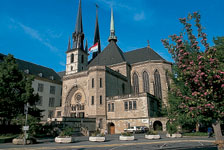 NOTRE
DAME DU LUXEMBOURG
NOTRE
DAME DU LUXEMBOURG
A l'origine, la cathédrale était une église jésuite, dont
la première pierre fut posée en 1613. L'église constitue un exemple remarquable
du gothique tardif, tout en présentant divers éléments et ornementations de
style Renaissance. A la fin du XVIIIe siècle, elle accueillit la statue
miraculeuse de la Consolatrice des Affligés, patronne du pays et de la ville de
Luxembourg. 50 ans plus tard, l'église reçut le titre sacré de Notre-Dame et, en
1879, le pape Pie IX l'éleva au rang de cathédrale. Entre 1935 et 1938, la
cathédrale Notre-Dame fut agrandie sur son côté sud.
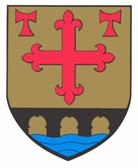
Beldorf
MULLERTHAL
la petite Suisse Luxembourgeoise
 |
 |
 |
 |
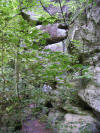 |
 |
 |
 |
 |
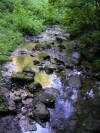 |
 |
 |
 |
 |
|
 |
 |
 |
 |
 |
ECHTERNACH
MULLERTHAL
Ville historique, fondée en
698 par le moine irlandais Willibrord. 5200 habitants. Altitude au-dessus de la
mer 160 m. Située dans le creux d'un méandre de la Sûre, à l'entrée de la Petite
Suisse luxembourgeoise et dans le parc naturel germano-luxembourgeois. 2000 ans
d'histoire ont laissé des vestiges architecturaux: palais romain avec pars
urbana et pars rustica. Eglise paroissiale SS Pierre et Paul mérovingienne,
romane, gothique. Basilique romane avec crypte et tombeau de st Willibrord. Sur
la place du Marché: croix de justice et hôtel de ville gothique. Restes de
l'enceinte médiévale avec 7 tours. Abbaye bénédictine baroque. Pavillon rococo
au parc municipal. 4 musées. Zone piétonne, centre récréatif avec lac de 60 ha.
70 Km de sentiers touristiques à travers des paysages rocheux et boisés.
Procession dansante le mardi de la Pentecôte. Festival de musique classique en
mai/juin depuis 1975.
Luxembourg 34 km. Trèves 27 km. Cologne 150 km. Liège 160 km. Paris 375 km.
Maastricht 200 km. Bruxelles 220 km.
![]() Echternach,
eastern Luxembourg. It lies along the Sûre River, at the German border,
northeast of Luxembourg city. A vacation resort for Trier (Trèves) in Roman
times, it developed around a Benedictine abbey founded in 698 by St. Willibrord.
The church named for Willibrord dates from the 11th and 13th centuries, though
its crypt, which contains the tomb of the saint, is somewhat older (c. 10th
century). Other landmarks in Echternach are the 13th-century parish church of
Saints Peter and Paul and the town hall (12th and 15th centuries), with a late
Gothic colonnade (1520–30). Another notable structure is the 11th-century
building that houses the Museum of Prehistory. A large portion of the town's
medieval ramparts remains, and Roman ruins are also in evidence.
Echternach,
eastern Luxembourg. It lies along the Sûre River, at the German border,
northeast of Luxembourg city. A vacation resort for Trier (Trèves) in Roman
times, it developed around a Benedictine abbey founded in 698 by St. Willibrord.
The church named for Willibrord dates from the 11th and 13th centuries, though
its crypt, which contains the tomb of the saint, is somewhat older (c. 10th
century). Other landmarks in Echternach are the 13th-century parish church of
Saints Peter and Paul and the town hall (12th and 15th centuries), with a late
Gothic colonnade (1520–30). Another notable structure is the 11th-century
building that houses the Museum of Prehistory. A large portion of the town's
medieval ramparts remains, and Roman ruins are also in evidence.
A busy resort and excursion centre, Echternach has mineral springs and is also
an agricultural market and food-processing centre. Plastics are manufactured.
Pop. (1991) 4,211.
Note : toute personne a
le droit à l'image, donc quiconque se voyant sur ces images
et ne voudrait pas y figurer, peut me contacter pour retirer les photos ou/et
vidéo en question